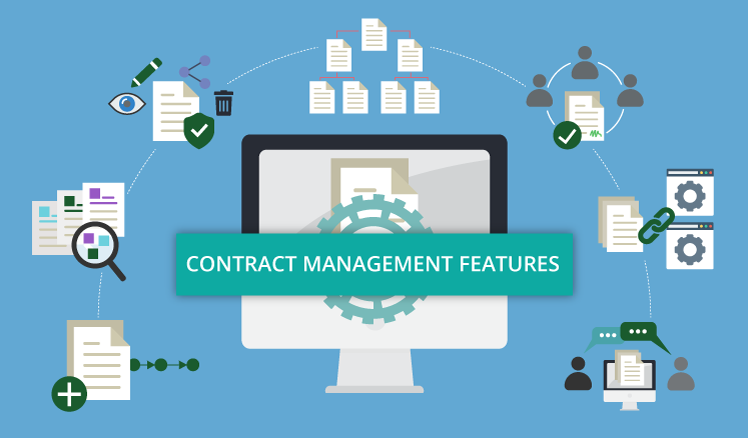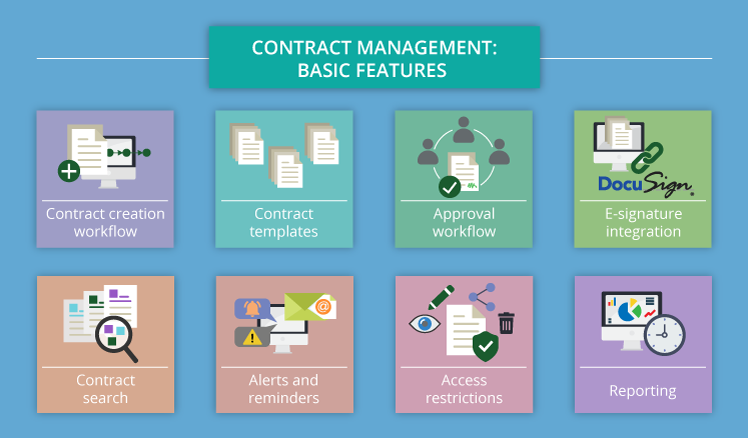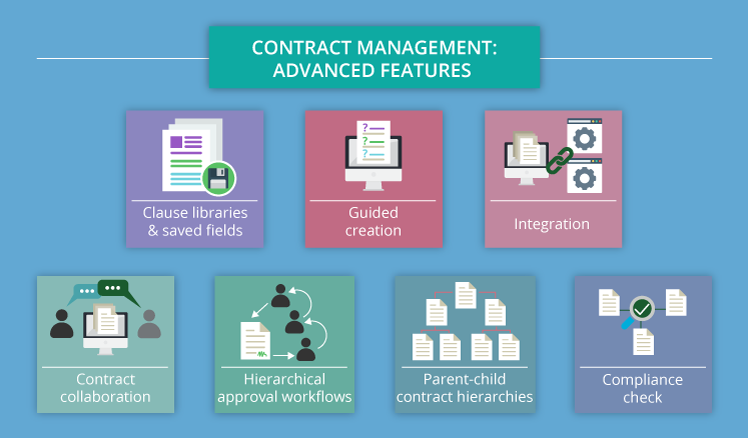On guard of business commitments: Contract management software features that support obligation management
Before deciding upon a certain contract management solution, it’s important to assess its key functionality. This article highlights basic and advanced contract management software features that are valuable for businesses, as they help to support obligation management.

Contract management & obligation management
The out-of-sight-out-of-mind approach to contract management when the actual management stops after the parties sign a contract and file it away is the road to nowhere. This may lead to overlooking the contract’s expiration or automatic renewal dates and, consequently, to penalties or lost revenue. In contrast, contract management software should provide constant access and control over contracts, until all related commitments are fulfilled, and further on, if any disputes arise after their termination. Thus, contract management is about obligation management in the first place. Due to automated alerts and notifications contract management software contributes to proper fulfillment of the obligations under the contract and encourages nurturing business relationships between the parties.
The market offers a variety of contract management software that can effectively automate contract-related business processes and make them faster, more efficient and convenient. Comprehensive solutions, for example, contract management software based on SharePoint, supervises each step of the contract processing, checks contracts against compliance regulations and keeps track of their important dates. Try our interactive demo to see an example of SharePoint contract lifecycle management.
So, let’s have a look at the extensive basic and advanced features of such software, define their value to business and see how they can provide seamless contract lifecycle management.
Contract management: basic features
Contract management software offers strong features that help to streamline contract lifecycle management:

Contract creation workflow
The first thing a contract’s author does is creating a new document and saving it in a folder of contract management software’s repository. They fill in metadata such as a customer’s name, a contract’s name, number, amount, etc., which helps to easily find the contract when needed. Depending on a contract type, the contract’s author can use templates that may be created for different types of contracts and stored in specific contract management software’s libraries. Also, contract management software allows the contract’s author to get a legal team’s advice during a contract authoring through online discussion boards or comments, which increases the efficiency of the contract creation process.
Contract templates
There’s no need in creating a contract from scratch each time, as contract management software allows making and using document templates. The templates simplify creating a new contract and save time. They may differ from contract to contract. For example, contracts involving high risk, high value, new or infrequent processes are likely to require a lot of negotiating. So, a template for this contract will have little detail and just outline its subject matter. It will contain full information only in typical paragraphs such as arbitration or force majeure. In contrast, a template for a contract that involves low risk, low value or routine processes is likely to be more complete, which saves time as you can use this template as a ready-made contract in many cases.
Approval workflow
Contract management software allows creating automated workflows for a contract’s approval. Users just need to define rules according to the contract type, value or specific metadata and set off a workflow. For example, while low-value contracts may need just 1 approval round by a legal team, high-value contracts may require 3 rounds and even more. Contract management software allows users to see each contract’s status: new, pending or approved. Moreover, due to versioning, users can see what changes were made. Each time the workflow participant presses Approve, the system generates a notification about it and routes next. After the final person in the workflow approves the contract, it’s possible to share it with the other party right through the contract management software. Thus, automated workflows accelerate the contract’s approval process.
E-signature integration
Contract management systems allow digitizing the whole lifecycle of a contract, even signing. Integration of contract management software with e-signature solutions such as DocuSign helps businesses to get legally binding signatures and simplify the process of their collecting due to saving time on printing and mailing. To collect multiple signatures, users can set off an electronic-signature workflow that routes the contract to all signing participants.
Contract search
It is important for business operations, as well as for audit, to find a contract and all associated documents including emails and comments easily and quickly. Luckily, a majority of contract management software offer powerful search based on document’s name, metadata or parts of content. It’s also possible to use a single query for conducting search through multiple sources such as libraries, portals, sites. Also, search results output should depend on user permissions, which increases information security.
Alerts & reminders
Each contract has several important dates, for example, the payment deadline. Missing the deadline may result in losing money for a business, as well as it may have an adverse effect on partnerships. And if we speak about large enterprises that have thousands of contracts in work, it becomes a serious challenge to keep an eye on all contracts’ deadlines and other milestones. Contract management provides scheduling automatic email notifications about important contract-related dates or events. This also helps to avoid automatic renewal of an unneeded contract and lets a business renegotiate its terms or initiate the contract termination.
Access restrictions
Contracts may contain sensitive information, especially contracts concerning high-value deals: usually, it’s a must not to disclose a customer and a contract’s amount. To avoid compromising sensitive data, it’s necessary to restrict access to the contract and related documents. Contract management software provides access based on various permission levels, which ensures that only authorized persons will view, download, edit, print or share the contract and supporting documents.
Reporting
The majority of contracts must meet compliance regulations such as SOX (Sarbanes–Oxley Act). It’s not an easy thing to check each contract against compliance regulations on a daily basis. Contract management systems may simplify this task by automated generating of reports using any metadata field. The software also provides a comprehensive audit trail that contains information on all contracts’ versions and the time and initiators of their creating, editing, approving, and sharing.
Contract management: advanced features
Apart from basic features, contract management software may provide the following advanced features that make handling contracts even more efficient:

Clause libraries & saved fields
Contract management software offers to store certain fields such as a vendor company’s name, addresses and contact details, approved contract clauses or legal terms in libraries to reuse them in new contracts. Using approved clauses in typical contracts rather than creating them from scratch saves time and protect companies against legal risks. Users may apply certain rules to these clauses. For example, they can lock a clause’s editing or protect a mandatory clause from deleting. It should be also possible to specify interchangeable and incompatible clauses for a specific contract.
Guided creation
Online questionnaires based on company policies and circumstances of a deal can help with the contract authoring, making it easier and faster. These questionnaires are an example of partial automation of contract creation. They are usually dynamic, as they ask users only relevant questions based on their previous answers. Answering contract-related questions, users enable automated adding of certain clauses to the contract from libraries. For example, if we create a domestic contract, its dispute resolution clause will differ from that of an international contract, as regards the procedure, court’s name and location and terms of settling disputes.
Integration
Contract management software can be integrated with CRM, CPQ, AP, ERP systems. Integration allows users to create, view, approve, and collaborate on contracts without switching between different applications, which ensures successful user adoption and increased productivity. Also, integration can affect contract authoring. For example, integration with CPQ leads to the quote’s automated inserting into relevant sections of the contract, which maintains contract documents always up to date. In addition, quote and proposal document revisions are linked so that changes either in figures or in shared language among documents stay in sync.
Contract collaboration
Besides co-authoring, contract management software allows internal and external users to collaborate without changing the document itself. This can be done through various tools for commenting, questioning and discussing. These tools can also accelerate decision-making and make the contract team’s work more effective. For example, instant messaging triggers interactions and exchanges on contract-related changes. Also, awareness and accountability of the contract team increases as compared to offline collaboration such as emailing, as everyone knows who is present and available for communication.
Hierarchical approval workflows
Contract management software allows creating hierarchical approval workflows: after a user approves a contract, it’s routed to higher ranking employees for approval. For example, a contract’s author creates a workflow, specifies its participants and sets it off. As a result, the contract is automatically routed to a CLO, a CFO, a COO and, finally, a CEO who signs it. After the contract is signed, its author is automatically informed that the contract is valid. Hierarchical approval workflows may reduce the contract approval time from days or even weeks to a couple of hours.
Parent-child contract hierarchies
Oftentimes, deals involve more than one contract. They may include a master contract with determined general terms that will govern future relationships between the parties (e.g. payment terms, intellectual property ownership, dispute resolution, etc.) and subordinate contracts that are more specific to the deal. In such a situation, there is a parent-child hierarchy in contracting relationships, and there is always a risk that the master contract and subordinate contracts would have conflicting provisions.
Contract management software can help to maintain consistency of the contract documents by linking related contracts and making changes across the entire hierarchy. A referencing procedure is assigned to the master contract to check whether a subordinate contract and the master contract have a matching contract type and contract fields. If the reference is valid, contract management software can copy data from the master contract into the subordinate contract according to previously set up rules. For example, if the termination date of the master contract changes, the same change will be done to the subordinate contract automatically.
Compliance check
It is difficult for businesses to manage all obligations under the contract at once due to a huge amount of businesses’ policies and regulatory requirements. Contract management software can help to meet compliance challenges by setting up certain rules. For example, according to the SOX requirements, a contract should be retained for 3 years after its cessation and contract management software provides scheduling automated deletion of contracts after a certain retention period. Also, due to its capability to generate reports and create audit trails, contract management software helps users to automate or partially automate contract compliance check.
To sum it up
With wide capabilities of contract management software features, handling contracts from creating to coming into force or renewal becomes more effective. For example, contract templates can be reused to create typical contracts over and over again and online questionnaires help to make a contract in a couple of clicks. Also, authors of contracts don’t need to track all contracts’ deadlines or other milestones, as contract management software will notify them about it automatically. Thus, contract management automation ensures that contracts and associated documents are always consistent, easily retrievable and up-to-date, which provides efficient obligation management and nurtures fruitful partnerships.

